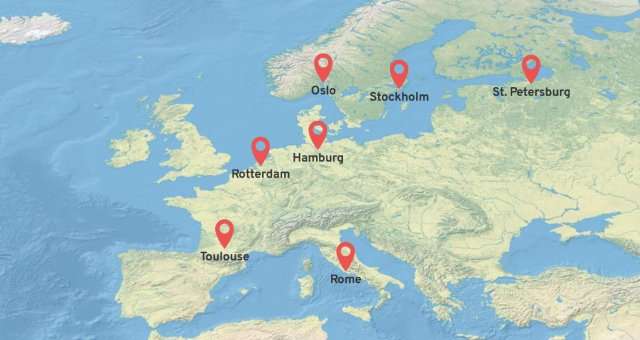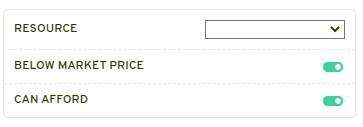
An Industry Idle guide that outlines three broad strategies and some tips for evolving your own expansion strategy in game.
Guide to Three Broad Strategies
This guide provides three strategies in a broad scope, but keep in mind that each of these strategies may vary vastly depending on how they are used specifically, what map is used, and more.
No-Deficit Strategies
The No-Deficit method is when you make all the stuff you need to create the final products yourself. Then, you sell those final products, usually automatically or with some trading. The money you get from selling helps you grow your business and makes your overall value go up.
In this strategy, the player produces consumer products without needing to buy any intermediate resources from the trade center or player trading area. Essentially, the production of every product is operating at just enough to produce all consumer products, or at a small surplus. Ideally, there is a small surplus in the production of each product to enable the player to fill wholesale orders.
When you’re doing the No-Deficit thing, you get better at making stuff little by little. You slowly increase how much you can make and sell of each thing. This means your money goes up slowly but you don’t have to pay for materials. You usually reset the game when you feel like you’ve earned enough in-game currency to get something good when you restart. Or, you might reset because you can’t automatically sell everything you’re making anymore.
Features of the No Deficit Method
- Growth in revenue and market cap is gradual.
- Stability in production, fuel, and power is very high.
- There are no outgoing operating costs.
- This method is likened to a more methodical approach to growth & expansion.
Tips for the No Deficit Method
- Try not to be reliant on products with a high price volatility (bitcoin & dogecoin) > Revenue fluctuations will slow your expansion, and surplus of these high price volatility resources will typically make it more difficult to reset, because you’ll want to wait for a good market price of those products in order to inflate your market cap and total $wiss received.
- Upgrade your product lines in small intervals; wait for your balance to build up a little bit, slowly upgrade each production area, working your way through the production line.
- Especially during the middle and later parts of your run, the policies: Heavy Iron, Silicon Valley, Aluminium Smelting, Industrial Revolution, Deforestation, & Supercharge Oil Well will become particularly useful because, while increasing your neccessary power and fuel and drawing policy points, they also provide a 2x effective mulitplier (while the policy is active) to the production of: Iron, Silicon, Aluminium, Coal, Wood, & Oil respectively. It costs 720 policy points
- per second to run all of these multipliers at once, more if you have additional policies enabled.
- Its always best to upgrade your low tier products first so that you have the resources required for the next tier of product before you build it. This is useful to avoid falling into deficit in the first place.
- If you are operating at a deficit, fill your deficits from highest tier to lowest, so that you’re eliminating the number of products in deficit and not having to repeatedly upgrade the same production type.
- Always plan out your building areas to best optimize your adjacency clusters (clustering production to gain adjacency bonus) and review your tile modifiers in each area before building to ensure you get maximum productivity.
- If you have excessive surplus, locate those products in the statistics center and downgrade or remove buildings where possible to clear permits.
High-Deficit Strategies
The High-Deficit method is a method by which the player produces only some of the neccessary materials to produce their consumer products. (Any product that is at the end of product line for that producer) In this method, revenue and growth are are attained much quicker and are typically seen at much higher levels. However, this method introduces heavy operating costs, as you need to buy enough resources to make up your deficit.
In this method, consumer products are sold via autosell or a combination of autosell and player trades to accumulate revenue and the purchase of deficit goods is done through the trade center, player trade, or, more commonly, through the ‘Shopping Spree’ policy [Expansion Pack 1].
In order to raise finance and market cap in the high deficit method, your revenue must be considerably higher than the cost to purchase and operate your company. This is achieved through profit margins. Below is a quick break-down of how profit margins work and how you can optimize your profits by making considered choices about production.
Profit margins work very simply. The profit margin of any building is the percentage net profit of that building as opposed to selling all the composite elements of the product individually. Take the example below.


In this example, the battery factory is consuming 230.4 Aluminium, Coal, & Iron to produce 230.4 Batteries. The prices for each item are seen in the first screenshot. (Above) The total cost to produce 230.4 Batteries (if you had bought the resources from the trade center) is $143,400.96.
- (230.4 * 358.7) + (230.4 * 215.6) + (230.4 * 48.1)
Since 230.4 Batteries have a total sale price (or value) of $203,420.16, producing Batteries in this factory provides a profit of $60,019.2 (per production cycle) This profit can be divided into the cost price to get the net profit margin.
- ((60019.2 / 143400.96) * 100)
This net profit margin comes out at ~41.8%, the very same value seen on the battery factory. Ok, now you know what profit margins are and how they work very simply with one factory. However, this applies to only one production. In reality, you will be producing things comprised of multiple composite products.
In those cases, the net profit margin on the final factory will be the net profit margin that that factory is generating in regards to its own composite products, not the raw inputs required to create it.
For example, Software Companies will show a profit margin that is based upon the profit returned from the prices of Phones, PCs, and Books in comparison with the value of Software.
It does not consider the materials to produce each of those respective composites. To calculate the profit margin for that entire production line leading up to and including that product (You would want to know this if your factories were producing intermediate products but purchasing the raw materials to produce those) you can sum up a list of all the raw materials involved in producing that product, and then run the same calculation that we saw above.
The below equation will hence give you the profit margin for that production line (It assumes that there are 4 raw inputs involved in creating the end product).
- (((Quantity of Final Product Produced * Value of Final Product)- Total Costs) / Total Costs)
Where:
- Total costs = ((Quantity of Input * Price of Input) + (Quantity of Input * Price of Input) + (Quantity of Input * Price of Input) + (Quantity of Input * Price of Input))
Profit margins are important in High-Deficit methods because they dictate how much profit you will make. If your production lines are making a negative profit margin, you will be losing money every second because your costs are outweighing your profits.
Profit margins are not completely in your control, but in order to maximize your total profit margin and maximize profits, you should aim to extend your production lines as long as possible, since profit margins have a rolling effect down the production line. Note that resources for fuel and power can also be purchased using deficit methods such as the Shopping Spree policy. [Expansion Pack 1]
An often successful strategy within the High-Deficit Method is to have two main products or product types that you sell; one, typically with a more consistent market price (For example, Software & Consoles) that you sell constantly, and another, typically more volatile (Internet or Dogecoin) that you produce at a lower rate than you can autosell, but only sell when the price is optimal.
This gives you a consistent revenue stream and makes the most of production efficiency (not allocating too much of your resources to high volatility products) while giving boost sell points as well. However, there are countless variations and ways to operate your company in a deficit, this is just an example I’ve personally observed.
Features of the High Deficit Method
- Growth in revenue and market cap is typically unstable but rapid in times of growth.
- Small falls in culture production (to run shopping spree and production policies) will bring things to a halt; your run is much more fragile.
- Stability in production, fuel, and power is very low.
- There are outgoing costs which have to be outweighed by your total revenue.
- This method is likened to a more sporadic and aggressive approach to expansion.
- Purchased deficits may be used to lighten the strain on permits or to completely replace the majority of production.
Tips for the High Deficit Method
- Just because you’re using a more profit-aggressive method, try to act methodically. Mindlessly upgrading things as soon as you can finance them is typically a bad idea. If you over expand one chain and receive a negative profit margin you could see a serious fall in profit.
- It’s a good idea to allocate your limited production inputs to the more expensive materials that are specific to your location. If plastic prices are high on your map, try producing plastic independently and buying a majority share in the rest of your resources.
- Always upgrade your factories from the simplest moving toward more and more complex products. This will ensure that your purchases [Shopping Spree] will be that of the lowest tier and not something part way up the production chain.
- Don’t use this strategy needlessly. If you have the cash and plenty of remaining permits, it’s best to produce more resources independently and purchase a smaller share. This strategy is more intended for permit-tight situations, late game expansion, or specializing purchases for specific low quantity resources.
- When having a moderate to high reliance on this strategy, try and keep your major purchasing inputs close to your trade center. You want to really centralize production as much as possible because the Shopping Spree purchases [Expansion Pack 1] and any other purchases from the trade center or player trading will be sent to your trade center. Having a distanced production line will massively increase your fuel consumption and may even cause disruptions in resource flow.
Price & Volume Trading Methods
Market Trading is, in my opinion, mostly a sub-strategy and will barely ever be used as a main revenue stream before end-game progression. However, to completely ignore market trading methods as a part of your progression is adverse.
Trading items on the market (And by market I am referring to both offline trade center and online player trade markets) is a great way to increase your revenue, clear extra stock from mounting surpluses, make the most of your market cap on resets, and turn earned revenue into more revenue.
Since this is such a broad category and I don’t plan to outline any very specific market elements in this guide, I’m just going to run over some helpful tips and strategies for trading on the market in Industry Idle. Note that trading becomes more relevant as you progress in the game. If you are on one of your first runs, this information may not be helpful. Market trading is also helpful if you don’t have a lot of time to actively expand and can instead wait to fill orders and check market prices whenever you get the chance.
Tips: when & how to trade (For the best results)
Having foresight about when you plan to liquidate and reset are important for market trading. A good strategy during the hours (or days) leading up to reset is to save up cash and wait for a product priced under it’s typical market valuation. Then, buy as great a volume of the product as you can (using saved cash), and when there’s an upturn in the market, reset using your inflated market cap or autosell the product for profits is the stock rating is unfavourable to reset at that time.
This strategy is good at any point in progression, not just before reset, but keep in mind that it’s most beneficial in the later stages when saving cash makes more sense than spending it on upgrading your production.
Another way to quickly make marginal gains in your market cap is to search the player market using the ‘Below Market Price’ & ‘Can Afford’ filter toggles. Keep in mind this does not impede on your player trade quota. Holding onto these products or reselling them for a profit immediately afterward is a good way to make small jumps in market cap with excess cash.

Produce a surplus with intent to sell on the online market. A good idea is to produce a modest surplus in a product you are already autoselling. This means that when the price is most favourable and people are looking to liquidate their products rather than purchase more (at market price), you can sell your surplus on the online market at a reasonable way below the market price. People with higher autosell capacity or looking to reset will see this as a way to quickly increase valuation and you will in turn receive a heavy bonus.
Run stop-losses on the market! For those who don’t know, stop-loss orders are orders where, if the price falls or rises past a certain point, you automatically fill or place an order. This is useful so that even if you aren’t online, or if you’re working on other things, you can be buying products at lows and selling at highs. In Industry Idle, this can be (somewhat) replicated by placing low price buy orders and high price sell orders. Keep in mind there will be a cap to how far you can push the limits, depending on the market price, and you need the product in stock to make a sell order.
Search through buy orders first before making a sell order, there may be a product being ordered at a higher price than you would offer. At the moment there is no system to automatically fill your order if supply/demand prices cross over like this but I expect it won’t happen any time soon because the way the market currently works is that the entire quantity of an order has to be filled. Having this change would result in drastic market changes.



Be the first to comment